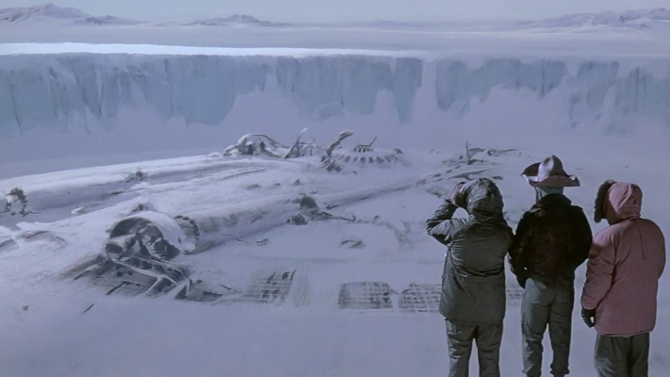
Voodoo, and Zombies, and Ghosts, Oh My
Beating the famed comedy duo of Abbott and Costello to the horror comedy circuit both one and two years prior to their 1941 classic Hold That Ghost, Bob Hope released The Cat and the Canary in 1939, following it up in quick succession (just eight months later) with The Ghost Breakers in 1940 – it was originally a play written by Paul Dickey and Charles W. Goddard (there are also two silent films from 1914 and 1922 based on it that are thought to be lost – the former being directed by Cecil B. DeMille). Directed by George Marshall, the mystery infused horror comedy follows a socialite, Mary Carter (Paulette Goddard), who has learned on a stormy New York night that she has inherited a supposedly haunted castle on a secluded Cuban isle ominously named Black.
-

A Bloody Funny Misunderstanding
Tucker and Dale vs EvilAugust 28, 2016Words are funny (and I don’t necessarily mean ha ha funny). Let me explain by way of an example: if I were to say, select the highest number between 5 and 8 – half of you would likely say 8, while some others would choose 7 (or 7.9), depending on how you perceive the word between. I use the word perceive, because perception is equally as fickle. Three people witnessing an automobile accident can sometimes see three very different things. Words and perception are used in clever fashion to exhume bloody humour in the 2010 comedy/horror flick Tucker and Dale vs. Evil. Co-writer/director Eli Craig (as well as second co-scribe Morgan Jurgenson) flip our perception of what ‘should be’ from the very beginning. Tucker (Alan Tudyk) and Dale (Tyler Labine) are two, for lack of a better word, hillbillies. . . but not those of horror past who enjoy slaughtering local travellers.
-

Conjure Up Some Scares
The ConjuringJuly 24, 2016I recently met up with actor Steve Coulter at CAPE Cornwall; he is perhaps best known for his turn as Reg Monroe in the television series The Walking Dead. Coulter has also worked an impressive five times with horror maestro James Wan (he has been directed by him four times as well as being in one of his productions). He plays the role of Father Gordon in Wan’s The Conjuring and its sequel The Conjuring 2. I reached out to him to get a quote on the filmmaker. Coulter had nothing but praise for the man, stating "James’s skill in directing horror is, first of all, based on his ability as a storyteller. He knows how smart the audience is, particularly the horror film audience. As such a fan of the horror genre, he knows the usual shortcuts that are made, and he doesn’t take them. He knows what REALLY scares people. And he is such a masterful filmmaker that he knows how to craft those scares so that they are truly frightening, not just the usual Hollywood jump scares. He’s also a master at building suspense." Keep an eye open for an upcoming Star Pick with the actor in the very near future.
-

Just One of Those Things
The ThingJune 10, 2016Back in 1982, a sci-fi horror film called The Thing got trashed by critics – perhaps it was due to it coming out around the same time as other sci-fi flicks like E.T. The Extraterrestrial and Blade Runner, or because it was too dark and edgy. . . or maybe it was simply ahead of its time. Funnily enough, it is now considered one of the all-time greats of the horror genre. Critics have come around to see the movie in a much more positive light – which explains why it has been placed onto countless lists that recognize great films, horror or otherwise.
-

Shine a Light
Julia's EyesJune 3, 2016Our eyes are the windows to the world. They are one of our most vital senses, and losing our vision is, in turn, probably one of every persons’ biggest fears. That is why the Spanish horror thriller Julia’s Eyes is one of the spookiest film concepts to come out in recent history. Written by Oriol Paulo and Guillem Morales (who also directs the picture), the visionary tale twists and turns as our protagonist, Julia Levin
-

Join the Madness
Spider Baby or, The Maddest Story Ever ToldMay 1, 2016Though I consider myself well versed in most areas of film, I must say that I knew nothing about the horror cult classic Spider Baby or, The Maddest Story Ever Told, until I began researching for my interview with Beverly Washburn, who starred in this quirky motion picture that was filmed in 1964, though it was only released in 1967 (due to issues with finances and poor distribution).
-

Do Look Now
Don't Look NowMarch 8, 2016The horror genre has many incarnations. The two that seem to be most popular as of this point are the slasher flick (i.e. Saw) or the based-on-true-events-style ghost story – à la Paranormal Activity, The Conjuring and so on. From time to time we may see a more traditional, even Victorian-style ghost story such as Crimson Peak or The Woman in Black, but the film I am reviewing today is much harder to pigeonhole, as it is part searing psychological drama, which is then mixed with Gothic horror and a touch of thriller. It is Nicolas Roeg’s 1973 slow-burner of a picture, Don’t Look Now.
